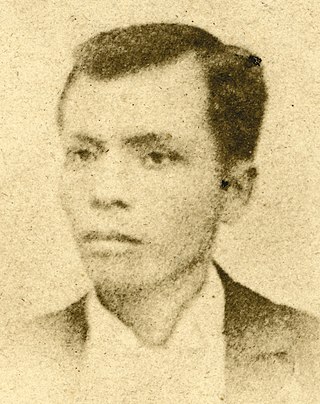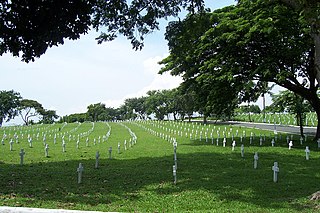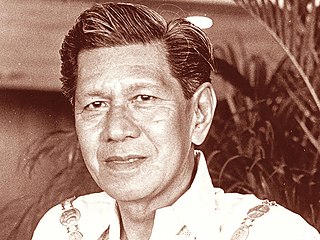
Emilio Aguinaldo y Famy was a Filipino revolutionary, statesman, and military leader who is the youngest president of the Philippines (1899–1901) and is recognized as the first president of the Philippines and of an Asian constitutional republic. He led Philippine forces first against Spain in the Philippine Revolution (1896–1898), then in the Spanish–American War (1898), and finally against the United States during the Philippine–American War (1899–1901).

Manuel Luis Quezon y Molina,, also known by his initials MLQ, was a Filipino lawyer, statesman, soldier, and politician who served as president of the Commonwealth of the Philippines from 1935 until his death in 1944. He was the first Filipino to head a government of the entire Philippines, and is considered to have been the second president of the Philippines, after Emilio Aguinaldo (1899–1901), whom Quezon defeated in the 1935 presidential election.

Andrés Bonifacio y de Castro was a Filipino Freemason and revolutionary leader. He is often called "The Father of the Philippine Revolution", and considered one of the national heroes of the Philippines. He was one of the founders and later the Kataastaasang Pangulo of the Kataastaasan, Kagalanggalangang Katipunan ng mga Anak ng Bayan or more commonly known as the "Katipunan", a movement which sought the independence of the Philippines from Spanish colonial rule and started the Tagalog Revolution. With the onset of the Revolution, Bonifacio reorganized the Katipunan into a revolutionary government, with himself as President (Pangulo) of a nation-state called "Haring Bayang Katagalugan", also "Republika ng Katagaluguan", where in "Tagalog" referred to all those born in the Philippine islands and not merely the Tagalog ethnic group. Hence, some historians have argued that he should be considered the First President of the Tagalogs instead of the Philippines; that is why he is not included in the current official line of succession.

Ramon del Fierro Magsaysay Sr. was a Filipino statesman who served as the seventh president of the Philippines, from December 30, 1953, until his death in an aircraft disaster on March 17, 1957. An automobile mechanic by profession, Magsaysay was appointed military governor of Zambales after his outstanding service as a guerrilla leader during the Pacific War. He then served two terms as Liberal Party congressman for Zambales's at-large district before being appointed Secretary of National Defense by President Elpidio Quirino. He was elected president under the banner of the Nacionalista Party. He was the first Philippine president born in the 20th century and the first to be born after the Spanish colonial era.

Elpidio Quirino y Rivera was a Filipino lawyer and politician who served as the sixth president of the Philippines from 1948 to 1953.

Sergio Osmeña Sr. was a Filipino lawyer and politician who served as the fourth president of the Philippines from 1944 to 1946. He was vice president under Manuel L. Quezon. Upon Quezon's sudden death in 1944, Osmeña succeeded him at age 65, becoming the oldest person to assume the Philippine presidency until Rodrigo Duterte took office in 2016 at age 71. A founder of the Nacionalista Party, Osmeña was also the first Visayan to become president.

Carlos Peña Romulo Sr. was a Filipino diplomat, statesman, soldier, journalist and author. He was a reporter at the age of 16, a newspaper editor by 20, and a publisher at 32. He was a co-founder of the Boy Scouts of the Philippines, a general in the US Army and the Philippine Army, university president, and president of the United Nations General Assembly.

Libingan ng mga Bayani is a national cemetery within Fort Andres Bonifacio in Metro Manila, Philippines.

Nicomedes "Nick" Marquez Joaquin was a Filipino writer and journalist best known for his short stories and novels in the English language. He also wrote using the pen name Quijano de Manila. Joaquin was conferred the rank and title of National Artist of the Philippines for Literature. He has been considered one of the most important Filipino writers, along with José Rizal and Claro M. Recto. Unlike Rizal and Recto, whose works were written in Spanish, Joaquin's major works were written in English despite being a native Spanish speaker.

The Philippine Legion of Honor was established by President Manuel Roxas, through Philippine Army Circular No. 60 dated July 3, 1947. The Philippine Legion of Honor was patterned after the Legion of Merit of the United States of America, and was meant to honor both civilians and members of the military, Filipino or foreign. Originally, like the U.S. Legion of Merit, the Philippine Legion of Honor had four classes, known as degrees, with Legionnaire being the basic rank, and Chief Commander being the highest. With the reform of the Philippine system of orders and decorations in 2003, the Philippine Legion of Honor's classes were renamed "ranks" instead of "degrees", and the ranks expanded.

America Is in the Heart, sometimes subtitled A Personal History, is a 1946 semi-autobiographical novel written by Filipino American immigrant poet, fiction writer, short story teller, and activist, Carlos Bulosan. The novel was one of the earliest published books that presented the experiences of the immigrant and working class based on an Asian American point of view and has been regarded as "[t]he premier text of the Filipino-American experience." In his introduction, journalist Carey McWilliams, who wrote a 1939 study about migrant farm labor in California, described America Is in the Heart as a “social classic” that reflected on the experiences of Filipino immigrants in America who were searching for the “promises of a better life”.
Philippine literature in English has its roots in the efforts of the United States, then engaged in a war with Filipino nationalist forces at the end of the 19th century. By 1901, public education was institutionalized in the Philippines, with English serving as the medium of instruction. That year, around 600 educators in the S.S. Thomas were tasked to replace the soldiers who had been serving as the first teachers. Outside the academe, the wide availability of reading materials, such as books and newspapers in English, helped Filipinos assimilate the language quickly. Today, 78.53% of the population can understand or speak English.

Jose Y. Dalisay Jr. is a Filipino writer. He has won numerous awards and prizes for fiction, poetry, drama, non-fiction and screenwriting, including 16 Palanca Awards.

The Civil Code of the Philippines is the product of the codification of private law in the Philippines. It is the general law that governs family and property relations in the Philippines. It was enacted in 1950, and remains in force to date with some significant amendments.

José E. Romero, Sr., commonly known as José E. Romero, was a statesman and diplomat from the Philippines. He represented Negros Oriental's Second District and was Majority Floor Leader during the Ninth and Tenth Philippine Legislatures and the First and Second National Assemblies of the Philippines. He was senator-elect of the First Congress of the Philippines and later became the first Philippine ambassador to the United Kingdom and Secretary of Education.

Of the seventeen presidents of the Philippines, a number have shown proficiency in languages other than English and Tagalog.

Roman Tecson Romulo is a Filipino politician and lawyer. He served as a member of House of Representatives representing the Lone District of Pasig for four consecutive terms from 2007 to 2016 and from 2019 to present. He is the son of former Foreign Affairs Secretary Alberto Romulo and grand-nephew of President of the United Nations General Assembly Carlos Romulo.

Napoleon "Nap" Genson Rama, PLH was a Filipino Visayan lawyer, journalist, and writer in English and Spanish from Cebu, Philippines. He was the Vice President of the 1971 Constitutional Convention and the Floor Leader of the 1986 Constitutional Commission. In 2011, he was awarded the Philippine Legion of Honor, the country's highest recognition, with the rank of Grand Commander on the 25th anniversary of the EDSA 1 Revolution by President Benigno S. Aquino III.

















